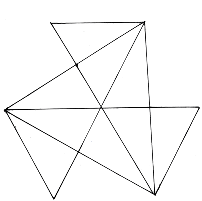|
NEW DISCOVERIES OF THE HEXA-DODECA-FLEXAGON |
by Ann Schwartz and Jeff Rutzky
I) Different Classes
of Faces. It's obvious from looking at the colored template that there are
faces that contain 12 triangles (the red face and the blue face) and others
that only have 6 triangles each (the green, yellow, violet, and brown faces).
But I now know that the faces actually break down into different categories.
If you look at the template carefully, you'll notice that the faces that
have only 6 triangles are distributed differently across the template.
One side of the strip
has all 6 brown triangles and no green triangles. The other side has all
6 green triangles and no brown triangles. However, each side has 3 yellow
triangles and 3 violet triangles. These differences not only affect the
behavior of the "lesser" faces, but also make some distinctions
between the two "greater" faces (red and blue). How the red
and blue triangles are positioned on the strip relative to the triangles
of lesser faces determines how they will function in the flexagon.
Let's call the classes
Alpha, Beta, Gamma, and Delta, and look at the characteristics of each.
A) Alpha Face. In
this flexagon, the Alpha face is blue. It is one of the two faces that
has 12 triangles. It is the only face that can exclusively form 3 positions
of the flexagon: the regular Radial (R1), Figure 17 in the eighthsquare.com
article; the Alternate Hexagon (AH), Figure 19, and the Propeller (P),
Figure 23. "Rogue Triangles," which I’ll now rename "Toggle
Triangles" for reasons that will become clear later, are always present
when alpha is in AH and P form: a property unique to Alpha. Alpha only
combines with Delta faces.
B) Beta Face. Red,
in the model. It is one the two faces that has 12 triangles. Its triangles
can exclusively form R1 and P. Beta only combines with Gamma faces.
C) Gamma Faces. Brown
and Green, in the model. Having only 6 triangles they must always "borrow"
triangles from another face. They only combine with Beta or each other.
They can appear in P and AH with Beta, or with each other exclusively
in Radial 1 (this Radial 1 variation discovered by Jeff). In this position,
Delta or Gamma faces appear two by two in adjacent pairs like the arrangement
of colors in Radial 2 (R2), Figure 22. And like the Radial 1 faces made
up exclusively of Alpha or Beta triangles, this R1 can always be flexed
along two axes, and the distribution of leaves is 5-1-5-1, etc.
D) Delta Faces. Violet
and yellow. They only combine with Alpha or with each other. Like Gamma,
they can appear in P, AH, and R1.
II. Tuckerman Traverse
(without the "worm hole," to be discussed later in this post)
I found four different
cycles that produce each color at least once. I started with an Alpha
or Beta face in R1. Twelve flexes produced a full cycle that could be
repeated. Alpha and Beta triangles always appeared in 6 of the 12 faces.
Each Gamma color appeared twice, always combined exclusively with its
"master," the Beta color (brown and red or green and red). Delta
colors each appeared once with Alpha. Here: violet and blue, or yellow
and blue. This still needs to be proved, but it looks like Delta triangles
appear less frequently than Gamma Triangles.
The positions appeared
this frequently per cycle: R1-2x, P-4x, AH-4x, R2-2x. The R1 variation
does not appear in this cycle.
III. The "Wormhole".
The R1 variation described above can be found in two different ways. When
Blue is in the AH, fold over the three Toggle (alias Rogue) Triangles
to form a symmetrically colored Propeller. Then flex the Propeller and
continue flexing. You will find yourself getting the R1 with Delta triangles
combining with each other and Gamma triangles combining with each other.
You will also get different arrangements of AH and P. The color combinations
will be the same, such as red with green. But before we went through the
Wormhole, the Propeller always had green in the middle. Now you should
be able to see it with a red triangle in the middle. (Thanks again, Jeff
Rutzky, for tell me about the true nature of these triangles!) So we see
that the "Rogues" had a twinkle in their eyes, and are not an
annoyance but play a key part in the flexagon. Once in "Wormhole"
Mode, you will NOT be able to produce Alpha and Beta in R1. To see them,
you'll have to go through the Wormhole: bend back the newly renamed Toggle
Triangles and flex.
And there's another
path through the looking glass! In R1, flex along 6 axes at once—not
easy. You'll have to perform a double-pass-through-reverse flex, to borrow
language from Build Your Own Polyhedra (Pedersen and Hilton, Pearson Publishing).
Easier said then done. Actually, I'm not even going to attempt to describe
the steps of this flex here! But it will bring you into Wormhole Mode.
Double-pass-through-reverse flex to get back again—or simply and
fold back the Toggle Triangles.
E) The total number
of hybrid faces has increased considerably (another Rutzky discovery).
Twenty-nine different combinations of the six basic faces can be seen
when you flex along three creases. For instance, AH with red in the middle
and green along the edges is one face, and AH with green in the middle
and red along the edges is another face. This total includes both the
two-colored faces and the ones that are exclusively Alpha or Beta.
But just when you
thought it was save to put this flexagon to rest and call it a day, another
way to flex, has raised its ugly (or beautiful, depending on your point
of view!) head.
I have just discovered
that is possible to flex the 12-gon along FOUR axes, and produce even
more color combinations! Stay tuned…
Copyright©EighthSquare.com P.O. Box 580, New York, NY 10113

